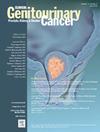mRNA-Based Urine Test Performance in High and Very-High Risk Non–Muscle-Invasive Bladder Cancer Patients Undergoing Contextual Endoscopic Follow-up (VERNAL: Vesical Tumor Early Monitoring: mRNA-Based Follow-up)
IF 2.7
3区 医学
Q3 ONCOLOGY
引用次数: 0
Abstract
Introduction and Objectives
Non–muscle-invasive bladder cancer (NMIBC) patients need a strict follow-up with cystoscopy (UCS) and voided urinary cytology (vUC) due to high rate of recurrence and progression. To reduce invasiveness and costs, a new diagnostic biomarker, namely Xpert Monitor BCⓇ—detecting 5 mRNAs in voided urine—, has been proposed. We test Xpert Monitor BCⓇ ability to detect tumor recurrence at an early point during follow-up of high risk (HR) or very high risk (VHR) NMIBC patients, aiming at evaluating reliability of this test as a single procedure.
Materials and Methods
Between September 2022 and July 2023 included, 80 HR or VHR NMIBC patients were prospectively enrolled. Both naïve and previously treated patients (including Bacillus Calmette-Guérin—BCG—and/or systemic immunotherapy) were admitted. Patients with known upper urinary tract urothelial carcinoma (UTUC) were excluded. Xpert Monitor BCⓇ test was carried out on precystoscopy voided urine samples. In case of suspicious urethra-cystoscopy (UCS), a transurethral resection (TURB) or a biopsy was indicated. vUC was usually prescribed to be performed prior to UCS. Negative predictive value (NVP), positive predictive value (PPV), sensitivity (SE) and specificity (SP) of Xpert Monitor BCⓇ and vUC, were assessed and compared with UCS and secondarily with histology at TURB/bladder biopsy.
Patients who proceeded with follow-up underwent a second evaluation with Xpert Monitor BCⓇ test.
Results
Seventy-six patients were evaluable. Median age was 70 years (interquartile range [IQR] 65-78) and 62 (81.6%) patients were male. VHR patients were 14 (18.4%), 47 (61.8%) had a history of carcinoma in situ (CIS) and 37 (49.3%) had multifocal disease while 51 patients (67.1%) had recurrent bladder cancer (BC).
BC recurred in 15 patients (19.7%): in 3 of them as a muscle-invasive bladder cancer (MIBC). Xpert Monitor BCⓇ showed a NPV, PPV, SE, SP of 95.3% (41/43), 57.6% (19/33), 90.5% (19/21) and 74.5% (41/55) respectively. When available, vUC displayed a NPV of 78.9% (30/38), a PPV of 75% (3/4), a SE of 27.3% (3/11) and a SP of 96.7% (30/31). Twenty patients underwent a subsequent Xpert Monitor BCⓇ test and UCS during their follow-up, and 3 had a bladder cancer recurrence. Of note Xpert Monitor BCⓇ was positive in all those 3 patients who previously tested positive despite a negative UC.
Conclusions
High NPV and SE of Xpert Monitor BCⓇ are confirmed in our HR and VHR NMIBC series. Apparent false positive tests may be regarded as suspicious for persistent/recurrent disease. Implementation of Xpert Monitor BCⓇ aiming at improving cancer detection is supported by these findings, and a single test based follow-up may be explored.
基于mrna的尿液检测在高危和极高危非肌浸润性膀胱癌患者内镜随访中的应用(VERNAL:膀胱肿瘤早期监测:基于mrna的随访)
简介与目的非肌肉浸润性膀胱癌(NMIBC)患者由于其高复发和进展率,需要严格的膀胱镜检查(UCS)和尿细胞学检查(vUC)随访。为了降低侵入性和成本,提出了一种新的诊断生物标志物,即Xpert Monitor BCⓇ-检测空尿中的5种mrna -。我们测试了Xpert Monitor BCⓇ在高风险(HR)或极高风险(VHR) NMIBC患者随访期间早期检测肿瘤复发的能力,旨在评估该测试作为单一程序的可靠性。材料和方法在2022年9月至2023年7月期间,前瞻性纳入80例HR或VHR NMIBC患者。naïve和先前治疗过的患者(包括卡介苗芽孢杆菌- gusamrin - bcg和/或全身免疫治疗)均入院。排除已知上尿路尿路上皮癌(UTUC)的患者。Xpert Monitor BCⓇ对膀胱前镜检查空尿标本进行检测。在可疑的尿道膀胱镜检查(UCS)的情况下,经尿道切除(TURB)或活检是指。vUC通常被规定在UCS之前进行。评估Xpert Monitor BCⓇ和vUC的阴性预测值(NVP)、阳性预测值(PPV)、敏感性(SE)和特异性(SP),并与UCS进行比较,其次与TURB/膀胱活检组织学进行比较。继续随访的患者使用Xpert Monitor BCⓇ测试进行第二次评估。结果76例患者可评价。中位年龄为70岁(四分位间距[IQR] 65 ~ 78),男性62例(81.6%)。VHR患者中有14例(18.4%),47例(61.8%)有原位癌病史,37例(49.3%)有多灶性疾病,51例(67.1%)有复发性膀胱癌(BC)。15例(19.7%)患者BC复发,其中3例为肌浸润性膀胱癌(MIBC)。Xpert Monitor BCⓇ的NPV、PPV、SE、SP分别为95.3%(41/43)、57.6%(19/33)、90.5%(19/21)和74.5%(41/55)。vUC的NPV为78.9% (30/38),PPV为75% (3/4),SE为27.3% (3/11),SP为96.7%(30/31)。20例患者在随访期间接受了Xpert Monitor BCⓇ检查和UCS,其中3例膀胱癌复发。值得注意的是,Xpert Monitor BCⓇ在所有之前检测呈阳性的3例患者中均呈阳性,尽管UC呈阴性。结论在我们的HR和VHR NMIBC系列中证实了Xpert Monitor BCⓇ的高NPV和SE。明显的假阳性试验可能被认为是持续/复发性疾病的可疑病例。Xpert Monitor BCⓇ旨在改善癌症检测的实施得到了这些发现的支持,并且可以探索基于单一测试的随访。
本文章由计算机程序翻译,如有差异,请以英文原文为准。
求助全文
约1分钟内获得全文
求助全文
来源期刊

Clinical genitourinary cancer
医学-泌尿学与肾脏学
CiteScore
5.20
自引率
6.20%
发文量
201
审稿时长
54 days
期刊介绍:
Clinical Genitourinary Cancer is a peer-reviewed journal that publishes original articles describing various aspects of clinical and translational research in genitourinary cancers. Clinical Genitourinary Cancer is devoted to articles on detection, diagnosis, prevention, and treatment of genitourinary cancers. The main emphasis is on recent scientific developments in all areas related to genitourinary malignancies. Specific areas of interest include clinical research and mechanistic approaches; drug sensitivity and resistance; gene and antisense therapy; pathology, markers, and prognostic indicators; chemoprevention strategies; multimodality therapy; and integration of various approaches.
 求助内容:
求助内容: 应助结果提醒方式:
应助结果提醒方式:


